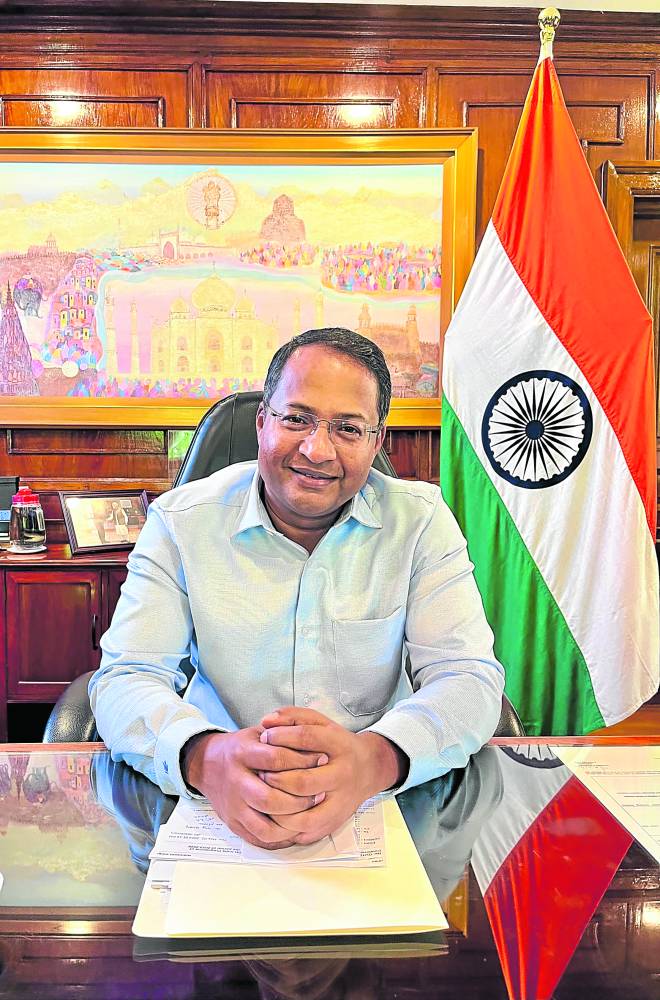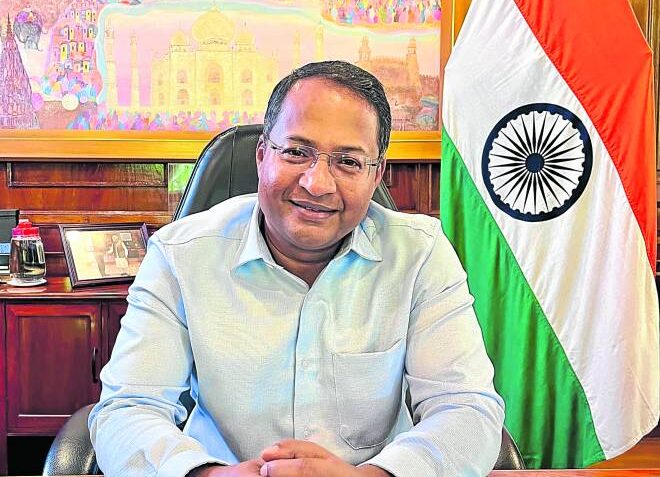
Arriving during the early part of the pandemic, India’s envoy to the Philippines had one vision: to keep his nose to the grindstone. In the past three years, Ambassador Shambhu Kumaran managed to thrive in pursuing his mission to make the relationship between India and the Philippines more consequential.
Now on the last year of his posting, Kumaran is busier than ever with talks and agreements on financial technology and science and technology programs. Next year will be a milestone, as the two countries will celebrate 75 years of diplomatic ties, which were established on Nov. 26, 1949.
Emerging power
Why should it matter? “Our ties are very ancient. If you look at the Filipino language, a lot of words that have to do with spirituality and culture have Indian roots. We traded ideas and goods for centuries,” said Kumaran. “As two key democracies with their share of complex developments, what India and Philippines do together will matter.”
The Philippines is dealing with the world’s fifth largest economy. India is projected to rank third place by the end of the decade. As an emerging power, it has joined several alliances such as the Shanghai Cooperation Organization, the world’s largest regional political and economic group; the Quadrilateral Security Dialogue, a network committed to support security and order in the Indo Pacific; and the BRICS (Brazil, Russia, India, China, South Africa) Alliance that bolsters economic cooperation among these fast-growing economies. Moreover, India presides over this year’s G20, a forum of countries with major roles in the global economy, and will host the 2023 G20 New Delhi Summit in September.
“India sees itself as a country with a rightful place in the global order,” said Kumaran.
In maintaining peace and order in the maritime territories, Philippine Coast Guard officials were deployed for training in India. Kumaran hopes to further reinforce the maritime cooperation.
India’s economic activity in the Philippines is vibrant. As the world’s largest business process outsourcing country, its companies here employ 200,000 Filipinos.
Pharmaceutics is India’s biggest export. “We are contributing effectively to the health security of the Filipinos because we are offering high-quality affordable medicines,” said Kumaran.
The interest in ancient Indian civilization and culture is reflected in the yoga activities. Likewise, there is a memorandum of agreement wherein experts from the National Institute of Ayurveda will assist the Philippine Institute of Traditional and Alternative Health Care in developing our traditional medicines.
The envoy observed that Indian cuisine is becoming popular with the rise of new restaurants not just in NCR, but also in Pampanga and Boracay.
In cultural diplomacy, the Philippine Madrigal Singers amazed the world when they rendered their signature choral rendition of Indian folk songs in a YouTube video. Ateneo de Manila co-produced the Tagalog broadcast of “Jantaka,” fables and stories on the life of Buddha for children.
Digital governance
The envoy also sees the potential for cooperation in governance. When President Ferdinand Marcos Jr. was newly elected, Kumaran introduced India’s digital governance initiative and how it benefited the poor. Through the Aadhaar, the resident’s identification number, government welfare subsidies (the equivalent of ayuda in the Philippines) were directly transferred to the zero-balance savings accounts of the poor.
“This is one of the biggest governance successes. It is of interest to a country like the Philippines where you have similar democratic challenges that need to be addressed in a democratic framework,” said Kumaran.
Aside from the government structure, Kumaran saw other similarities that put him at ease when he came here in 2020.
“I could sense the generosity of spirit. Filipinos are very engaged. Like India, you are a globalized nation. There are Filipinos in every part of the world as there are Indians. You are naturally curious about what is happening. There is interest in building relations. I found that easy to connect with,” he said.
To engage with the locals, he picked up golf. “I found that to be a useful addition to social interactions with a purpose. You meet interesting people who are golfers. They provide a common bond for you to stay in touch,” he said.
‘Sinigang’ at home
A typical day consists of paper work and meeting with Filipino government officials. “We try to move our relationship forward all the time,” he said. Aside from socials, the ambassador hosts meals, a form of gastronomic diplomacy, for an assortment of guests—members of the diplomatic corps, Indian businessmen, Filipino academics and even yoga teachers.
Guests anticipate the Indian cuisine prepared by his wife and a Filipina chef. Kumaran has developed a liking for sinigang, which is occasionally served at home, and the comfort foods sisig and bangus. The buko and mangoes remind him of his home state in Kerala.
When the country reopened, Kumaran explored Luzon and enjoyed Boracay and Palawan. “The beaches in the Philippines are unparalleled in beauty and in their crystal-clear waters. I take that as the dominant memory of my trips,” he said.
Like most envoys, Kumaran hopes to see more tourism and business between both countries and visits from top-level officials from India to mark the 75th anniversary of India and Philippine ties.
“We established diplomatic relations as young democracies since 1949, and we have since seen the expansion of partnership.” —CONTRIBUTED














































